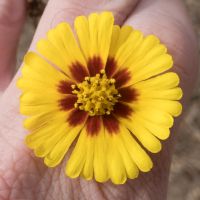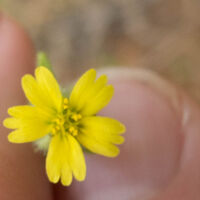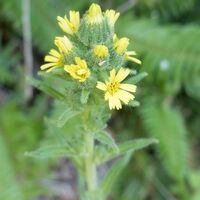tarweeds
genus Madia
Member of
tarweeds and allies (tribe Madieae)
sunflower family (family Asteraceae)
dicots (class Magnoliopsida)
flowering plants (subphylum Angiospermae)
There are no other wild species of this genus in the bay area.
See also woodland madia (Anisocarpus madioides).
relatively large diameter flower head
Madia elegans
- stem 6–250 cm, proximally soft- to coarse-hairy, distally glandular-hairy
- leaf 3–20 cm, 2–10 mm wide, lanceolate to linear
- heads in open, flat-topped clusters
- involucre 4.5–12 mm, ± coarse- or soft-hairy, generally also glandular-hairy
- phyllary tips erect or reflexed, flat
- phyllaries extend partway up petal (example)
- 25–80 disk flowers, staminate
- 5–22 ray flowers, 4–20 mm, relatively narrow petals, bright yellow, often maroon at base
- scattered, especially south of the bay
Madia radiata
- stem 10–90 cm, glandular-hairy
- leaf 2–10 cm, 4–15 mm wide, lanceolate to linear
- heads in open, ± flat-topped clusters
- involucre 4–7 mm, soft-hairy to bristly, hairs hooked at tip, and glandular-hairy
- phyllary tips ± erect or reflexed, flat
- 18–65 disk flowers, anthers yellow to ± brown
- 8–16 ray flowers, 6–19 mm, relatively wide petals, golden yellow
- La Honda Creek
relatively small diameter flower head
lemon scented madia
Madia citriodora
- stem 10–70 cm, proximally hairy, distally gladular-hairy, glands purple
- leaf 2–9 cm, 1–10 mm wide, linear
- heads in open, flat-topped clusters
- involucre 6–8 mm, glandular-hairy, often sparsely so
- phyllary tips generally ± erect, flat
- 8–50+ disk flower, anthers ± dark purple
- 5–12 ray flowers, 4–11 mm, green-yellow
- out of its normal range at Henry Coe
Madia gracilis
- stem 6–100 cm, proximally soft- to coarse-hairy, distally glandular-hairy
- leaf 1–10 cm, 1–8 mm wide, oblong to linear
- heads in ± open, panicle- or raceme-like clusters
- involucre 5–10 mm, finely or coarsely glandular-hairy
- phyllary tips erect or ± reflexed, flat
- 2–16+ disk flowers, anthers ± dark purple
- 3–10 ray flowers, 1.5–8 mm, lemon-yellow or green-yellow
- very common
- see also the similar common hareleaf (Lagophylla ramosissima).
Madia sativa
Not to be confused with coastal tarweed (Deinandra corymbosa).
- stem 35–100 cm, coarse- and glandular-hairy throughout
- leaf 2–18 cm, 3–18 mm wide, broadly lanceolate to linear-oblong or linear
- heads in generally crowded, panicle-, raceme-, or spike-like clusters
- involucre 6–16 mm, coarse- and glandular-hairy
- phyllary tips erect or ± reflexed, flat
- 11–45+ disk flowers, anthers ± dark purple
- (5)8–13 ray flowers, 1.5–4 mm, green-yellow or occasionally purple-red abaxially or throughout
- very common
plump seeded madia
Madia anomala
- stem 20–55 cm, coarse-hairy, distally glandular-hairy
- heads in flat-topped, raceme-, or panicle-like clusters; involucre 5–10 mm; mostly away from immediate coast
- leaf 2–10 cm, 2–7 mm wide, linear
- heads in open, raceme- or panicle-like clusters
- involucre 6–10 mm, coarse-hairy and glandular-hairy
- phyllary tips erect or ± reflexed, flat
- 3–8 disk flowers, anthers ± dark purple
- 3–8 ray flowers, 3–4.5 mm, green-yellow
- Sunol, Mt. Tam
Madia exigua
See also the very similar opposite-leaved tarweed (Hemizonella minima) (with comparison notes).
- stem 1–30 cm, coarse- and glandular-hairy
- leaf 0.2–4 cm, 0.5–2 mm wide, linear
- heads in open, flat-topped or raceme- or panicle-like clusters
- involucre 2.5–5 mm, ± coarse- and glandular-hairy
- phyllary tips ± erect, grooved along midvein [not visible in CalPhotos]
- 1(2) disk flower, anthers yellow to ± brown
- 1–8 ray flowers, 0.7–1 mm, pale yellow
- scattered
4 observed taxons / 3 unobserved taxons / 1 key
Locations: Months: For more details, use advanced search.
Chris’s observations: 57 (41 are research grade)
Taxon info: iNaturalist – Calflora – Jepson eFlora – FNA
Bay Area species: iNaturalist – Calflora



